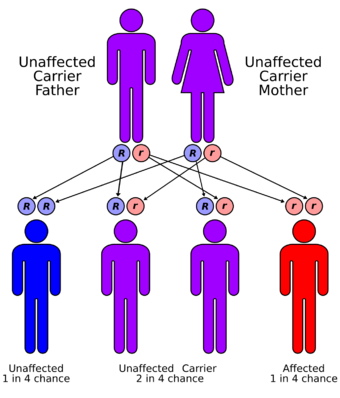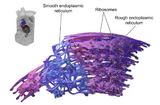Medicine:Arterial tortuosity syndrome
| Arterial tortuosity syndrome (ATS) | |
|---|---|
 | |
| Arterial tortuosity syndrome has an autosomal recessive pattern of inheritance | |
| Symptoms | Congenital diaphragmatic hernia[1] |
| Causes | Mutations in SLC2A10 gene[2][3] |
| Diagnostic method | CT scan, MRI [4] |
| Treatment | Possible surgery for aortic aneurysms[5] |
Arterial tortuosity syndrome is an extremely rare congenital connective tissue condition disorder characterized by tortuosity, elongation, stenosis, or aneurysms in major and medium-size arteries including the aorta.[1][6][7] It is associated with hyperextensible skin and hypermobility of joints, however symptoms vary depending on the person. Because ATS is so rare, relatively little is known about the disease compared to more common diseases.
Signs and symptoms
Major manifestations affect the cardiovascular system.
- Tortuosity and elongation of major and medium sized arteries.
- Stenosis or narrowing of major and medium sized arteries.
- Aneurysms or dilations of major and medium sized arteries
- Aortic valve regurgitation
- Hypertension
Non-cardiac signs and symptoms demonstrated by this condition include:[1][5]
- Arachnodactyly
- Autonomic dysfunction
- Blepharophimosis
- Congenital diaphragmatic hernia
- Keratoconus
- Mental dysfunction
- Telangiectasia (small clusters of enlarged blood vessels just under the skin).
Genetics
Arterial tortuosity syndrome exhibits autosomal recessive inheritance, and the responsible gene is located at chromosome 20q13.[6][2] The gene associated with arterial tortuosity syndrome is SLC2A10 and has at least 23 mutations in those individuals found to have the aforementioned condition.[2][3]
Pathophysiology
The mechanism of this condition is apparently controlled by (or due to) the SLC2A10 gene.[7] The molecular genetic pathogenesis finds that the SLC2A10 gene encodes the GLUT10 protein which is found in the nuclear membrane, or the endoplasmic reticulum, the latter of which GLUT10 transports DHA into. Clinically speaking, according to one review, the condition of tortuosity is seen more with the advance of age.[7][8]
Diagnosis
The diagnosis of Arterial Tortuosity Syndrome is established in a person with (1) generalized arterial tortuosity and (2) positive molecular genetic testing that identifies a pathogenic mutation in the SLC2A10 gene.[9] Generalized arterial tortuosity can be identified through the following:
- Physical examination
- Echocardiogram
- CT or MRI imaging and angiography
Treatment
Individuals with ATS benefit from a coordinated approach of multidisciplinary specialists in a medical center familiar with ATS.[7] No evidence-based clinical practice guidelines for arterial tortuosity syndrome (ATS) have been published.[7]
The treatment of arterial tortuosity syndrome entails possible surgery for aortic aneurysms, as well as regular clinical surveillance including regular follow-up echocardiograms.[7]
The prognosis and lifespan of this condition are unclear. Early reports of mortality were high,[10] but more recent data suggests about 12% mortality.[5][11]
References
- ↑ 1.0 1.1 1.2 "Arterial tortuosity syndrome | Genetic and Rare Diseases Information Center (GARD) – an NCATS Program" (in en). https://rarediseases.info.nih.gov/diseases/774/arterial-tortuosity-syndrome.
- ↑ 2.0 2.1 2.2 Reference, Genetics Home. "SLC2A10 gene" (in en). https://ghr.nlm.nih.gov/gene/SLC2A10#conditions.
- ↑ 3.0 3.1 "OMIM Entry - # 208050 - ARTERIAL TORTUOSITY SYNDROME; ATS" (in en-us). https://omim.org/entry/208050.
- ↑ Callewaert, Bert; De Paepe, Anne; Coucke, Paul (1993-01-01). "Arterial Tortuosity Syndrome". in Pagon, Roberta A.. GeneReviews. Seattle (WA): University of Washington, Seattle. https://www.ncbi.nlm.nih.gov/books/NBK253404/.update 2014
- ↑ 5.0 5.1 5.2 RESERVED, INSERM US14 -- ALL RIGHTS. "Orphanet: Arterial tortuosity syndrome" (in en). http://www.orpha.net/consor/cgi-bin/OC_Exp.php?lng=en&Expert=3342.
- ↑ 6.0 6.1 Reference, Genetics Home. "arterial tortuosity syndrome" (in en). https://ghr.nlm.nih.gov/condition/arterial-tortuosity-syndrome.
- ↑ 7.0 7.1 7.2 7.3 7.4 7.5 Callewaert, Bert; De Paepe, Anne; Coucke, Paul (1993), Adam, Margaret P.; Everman, David B.; Mirzaa, Ghayda M. et al., eds., "Arterial Tortuosity Syndrome", GeneReviews® (Seattle (WA): University of Washington, Seattle), PMID 25392904, http://www.ncbi.nlm.nih.gov/books/NBK253404/, retrieved 2023-02-10
- ↑ Morris, Shaine A. (2017-03-23). "Arterial Tortuosity in Genetic Arteriopathies". Current Opinion in Cardiology 30 (6): 587–593. doi:10.1097/HCO.0000000000000218. ISSN 0268-4705. PMID 26398550.
- ↑ "Arterial tortuosity syndrome - Conditions - GTR - NCBI" (in en). https://www.ncbi.nlm.nih.gov/gtr/conditions/C1859726/.
- ↑ Wessels, Marja W.; Catsman-Berrevoets, Coriene E.; Mancini, Grazia M. S.; Breuning, Martijn H.; Hoogeboom, Jeanette J. M.; Stroink, Hans; Frohn-Mulder, Ingrid; Coucke, Paul J. et al. (2004-12-01). "Three new families with arterial tortuosity syndrome". American Journal of Medical Genetics. Part A 131 (2): 134–143. doi:10.1002/ajmg.a.30272. ISSN 1552-4825. PMID 15529317. https://pubmed.ncbi.nlm.nih.gov/15529317/.
- ↑ Saudubray, Jean-Marie; Baumgartner, Matthias R.; Walter, John (2016) (in en). Inborn Metabolic Diseases: Diagnosis and Treatment. Springer. p. 181. ISBN 9783662497715. https://books.google.com/books?id=m9N5DQAAQBAJ&q=arterial+tortuosity+syndrome+treatment&pg=PA181.
Further reading
- Segade, Fernando (16 July 2010). "Glucose transporter 10 and arterial tortuosity syndrome: the vitamin C connection". FEBS Letters 584 (14): 2990–2994. doi:10.1016/j.febslet.2010.06.011. ISSN 1873-3468. PMID 20547159.Review
- Wetzel-Strong, Sarah E; Detter, Matthew R; Marchuk, Douglas A (2017-01-01). "The pathobiology of vascular malformations: insights from human and model organism genetics" (in en). The Journal of Pathology 241 (2): 281–293. doi:10.1002/path.4844. ISSN 1096-9896. PMID 27859310.
- Albuisson, Juliette; Moceri, Pamela; Flori, Elisabeth; Belli, Emre; Gronier, Céline; Jeunemaitre, Xavier (2017-03-21). "Clinical utility gene card for: Arterial tortuosity syndrome". European Journal of Human Genetics 23 (10): 1432. doi:10.1038/ejhg.2014.294. ISSN 1018-4813. PMID 25604859.
External links
| Classification | |
|---|---|
| External resources |
 |


